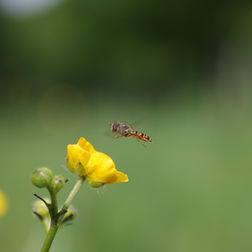Attracting Native Pollinators
Pollination is a critically important service for growers, and tends to be the limiting factor for yields. Despite the common practice of bringing in honeybee hives for pollination, many farmers still achieve below maximum yields due to limitations on pollination. Wild bees and honeybees provide comparable amounts of pollination for most crops, even in agriculturally intensive regions, and declining pollinator populations could make these limitations worse.*
Therefore, improving pollinator habitat on the farm and increasing the number of native pollinators and other beneficial insects has the potential to not only improve the general state of pollinator populations, but could also result in increased yields.

Benefits of native insect pollinators
Native insect pollinators are essential to the health of the farm. In many ways they are more efficient than honeybees, and because they have evolved to withstand local weather, they will also continue to pollinate in cooler, wetter, and windier conditions than honeybees.
Certain crops just won't do well without native pollinators. Bumblebees and solitary bees can pollinate using 'buzz pollination', a technique in which they vibrate their bodies to release pollen from a flower. Honeybees are incapable of this, and thus are less effectual at pollinating certain crops such as blueberries, tomatoes, peppers, or cranberries.
In addition to direct crop benefits, native pollinators are also just a regular part of the natural world and do not require specific management, care or equipment. If they have the basics they need to survive (flowers all season long, shelter from pesticides, and some nesting areas), then they will stick around and provide their services for free.
Creating pollinator habitat
Attracting more pollinators to an area is as simple as providing flowers and giving them somewhere to live. Leaving large natural habitat areas undisturbed is the best practice to encourage these insects, as it already provides both food and shelter, but if there are no natural areas nearby then creating habitat areas can still be beneficial. Planting windbreaks or hedgerows in underused areas or along fence lines offers shelter for pollinators, provides food, and also creates nesting areas.
To create refuge habitat, plant native long-blooming wildflowers such as yarrow, brown-eyed susan, showy milkweed, and asters to provide year-round nectar for the pollinators to eat after fruit trees have finished flowering. Even predatory insects can live twice as long when there are flowers around, as they will also eat nectar if they temporarily can’t find prey. Shrubs like wild rose, mock-orange or willow provide habitat structure. Many pollinators and predatory insects need dead wood for nesting; this can include fallen logs, untreated fence posts, and even old wooden sheds. Bumble, mining, and carpenter bees need loose, bare soil for nesting.
In the Okanagan, there are two nurseries that specialize in native plants:
Sagrbrush Nursery: www.sagebrushnursery.com
Xen Xeriscape Endemic Nursery: www.xeriscapenursery.ca/
Best Management Practices for Polliantors
-
Avoid using "bee houses" unless you are willing to follow proper procedures. These tube-filled boxes tend to concentrate too many bees into one spot and can lead to high levels of disease and more parasites
-
Reduce pesticide use as much as possible. Low-intervention or spray-free should be the goal. Read more on Chemical Intervention and Integrated Pest Management
-
If there are natural habitat areas on the farm, leave them alone and avoid tidying the "mess". Natural habitats need complexity to be functional.
-
Provide full-season food. Pollinators and beneficial insects don't just come around when fruit trees are in bloom - they live on the farm all year round. Make sure there are always flowers blooming in and around the orchard.
-
Give them clean water. Ensure there is clean, unpolluted water somewhere near the orchard. Artificial water sources (troughs, pools, etc) need to have rocks or other resting spots above the water's surface so insects can land to drink without drowning.
Bee houses require specific maintenance in order to not become death traps. Each year, all of the paper nesting tubes must be taken out (bee houses MUST have removable paper tubes) and all the larvae removed, cleaned, and overwintered in a safe place. The whole box must be sanitised and a full set of new paper tubes must be inserted for the spring.


Natural habitat areas on the farm
Leaving large natural habitat areas undisturbed is the best practice to encourage pollinators and other beneficial insects, as it already provides both food and shelter. Natural areas act as windbreaks and provide soil stability. If there is a natural water source nearby, such as a pond or seepage area, the water can act as a temperature regulator, cooling the air during heat waves and reducing the severity of cold snaps. Natural areas also provide habitat for larger beneficial wildlife such as insect-eating birds and sparrow-eating hawks and falcons. (See more about Integrated Pest Management)
Further Reading
The following resources are information-only. Find the Financial Assistance page here
Pollinator Partnership Canada Agriculture resource library
https://pollinatorpartnership.ca/en/ag-guides
Xerces Society for Invertebrate Conservation: Agricultural resource library
https://xerces.org/pollinator-conservation/farmland
Bumblebee Conservation Society: Managing orchards for Bumblebees
Government of BC Field guide to Beneficial Insects:
https://www2.gov.bc.ca/assets/gov/farming-natural-resources-and-industry/agriculture-and-seafood/animal-and-crops/plant-health/beneficial_insects.pdf
Sustainable Agriculture Research and Education program: Cover Cropping for Pollinators and Beneficial Insects


















